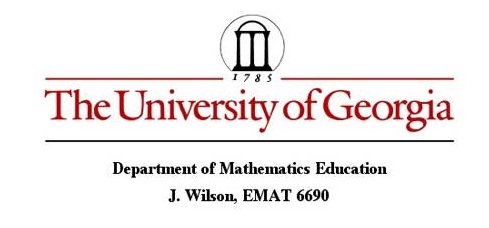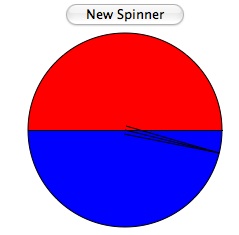

One of the problems kids often face is the difference between theoretical probability and experimental probability. To help kids to identify this patterns is not only enough to tell them that theoretical probability is the a priory probability and the experimental probability is the aposteriory.
Activities
1. Calculate the theoretical probability for a two color spin divide in equal areas and then calculate a experimental probability using this spinner

2. Compare the differences between theoretical probability and experimental probability and explain your conclusions.
One of the misconception literature has identified in student probabilistic thinking is the misconception called "sample space misconception" in which student hope to get the theoretical probability from small samples. Next activity will help students to understand the variability in small samples. Students should develop an explicit understanding of the notion that the more times they repeat an experiment, the closer the results will be to the expected mathematical model. If somebody flips a penny 10 times to obtain empirical data, it is quite possible that he or she will not get 5 heads and 5 tails. However, if the that person flips the coin a hundreds of times, we would expect to see that results will begin stabilizing to the expected probabilities of 50% heads and 50% tails. This is known as the Law of Large Numbers.
3. Toss four coin at the same time 10 times, count the number of heads in tossing the coins and then then fill out the table in which appear the theoretical probabilities.

compare the differences got between theoretical and experimental probability.
4. Toss four coin at the same time 50 times, count the number of heads in tossing the coins and then then fill out the table in which appear the theoretical probabilities.

Compare the differences got between theoretical and experimental probability.
Compare the values got in part 3 and part 4. What experimental probability is closer to the theoretical probability and explain the reason.
5. Mary and John are making
bet tossing coins. Mary has proposed John the following bet: if
after tossing three coins at the same time we get 2 or more heads
I will pay you 25 cent, otherwise you will pay me 30 cent. if
you were John would you accept the bet? Explain why or why not.
References
Tversky, A., & Kahneman, D. (1982). Causal schemas in judgments under uncertainty. In D. Kahneman, P. Slovic, & A. Tversky (Eds.), Judgment under uncertainty: Heuristics and biases (pp. 117-128). Cambridge, UK: Cambridge University Press.
Kennedy L. (1984) Guideng Children's Learning of Mathematics. Belmont, California: Wadsworth Publishing Company
Franklin C. et al (2005) . A Curriculum Framework for PreK-12 Statistics
Education. ASA